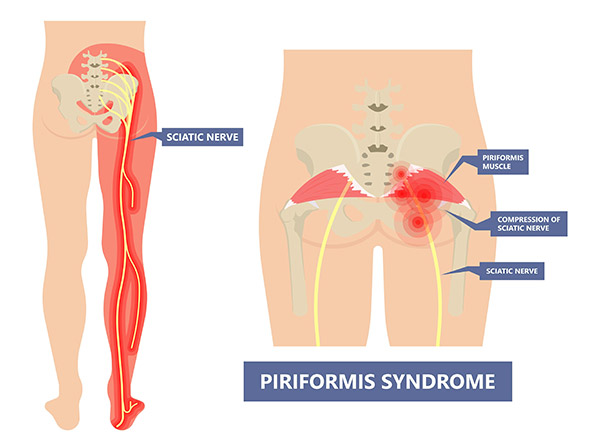What is Deep Gluteal Syndrome?
By: Dr. Kevin McIntyre B.Kin., DC
Quite often, patients attend our clinic with buttock pain. There are many different causes for pain in this area. The pain can be coming from the lower back, the sacroiliac joint, the hip joint, muscles in the area or the pain can also be stemming from nerve entrapment. Deep gluteal syndrome is a relatively new term used to describe a few different causes of pain in this area. Most commonly, it is referring to nerve entrapment in the buttock area that is not coming from the spine.
There are various muscles in the region of the buttocks. Gluteus medius, minimus and maximus are probably the most well-known. The piriformis is a horizontally oriented muscle that lies deep to the gluteus maximus muscle, and it is also well known, especially given its relationship to the sciatic nerve. Usually, the sciatic nerve courses underneath it. In a small percentage of the population, the nerve courses through the muscle. Occasionally the muscle irritates or entraps the sciatic nerve and creates nerve pain in the buttock. This is called piriformis syndrome. In my opinion, this condition is often over-diagnosed by practitioners, and in most circumstances, the nerve irritation is stemming from irritation in the lumbar spine.
Newer literature has shed light on sciatic nerve entrapment in the buttock area and has taught us that the piriformis is not the only muscle that can entrap the nerve. The obturator internus, levator ani, gemelli and coccygeus muscle can also entrap or irritate the sciatic nerve. The symptom pattern from these other muscle entrapment sites is not different from the symptoms in piriformis syndrome. Due to this, the term “deep gluteal syndrome” was invented. In the absence of imaging or further objective evidence that the piriformis is entrapping the nerve, we should probably use the clinical diagnosis of deep gluteal syndrome to acknowledge that there are various causes of sciatic entrapment in the posterior hip area other than the more well-known piriformis entrapment.
Deep Gluteal Syndrome Systematic Review
As we’ve mentioned many times on our blog site, a systematic review is a very good level of scientific evidence. It’s a pooling of many different research papers to decipher “what we know” on a given topic. A 2020 systematic review on deep gluteal syndrome gave us a better understanding of the condition. One of the findings in this paper was a clearer criteria for diagnosing deep gluteal syndrome. They suggested that there has to be sciatic nerve pain, the irritation of the nerve cannot be coming from the spinal discs (or pain from the discs) and the entrapment has to be deep in the gluteal space. Most patients with deep gluteal syndrome experience pain in the buttock. It is aggravated when sitting for longer than twenty to thirty minutes. There is usually tenderness in the buttock that reproduces the pain sensation when pressed. (For the practitioners out there, a positive seated piriformis test and a positive pace sign also help to rule in the diagnosis). From my perspective, we don’t need imaging to move forward with a recovery plan for this condition. If the pain is persisting and not improving, then perhaps imaging might be warranted. If imaging has been performed, it would be important to rule out any spinal causes for the nerve irritation or perhaps rule in any muscular entrapment around the gluteal space. Injections or nerve conduction testing can also assist in making the diagnosis, but again, it usually isn’t necessary.
Perhaps worth noting is that there are many different causes of pain in the buttocks. It doesn’t even need to involve the sciatic nerve. Some authors have broadened the diagnostic causes of deep gluteal syndrome to include conditions that are not related to nerve irritation. These causes might include bursitis, tendinopathy, muscular injury not involving the sciatic nerve or other nerve entrapments that are not part of the sciatic distribution. Perhaps the take-home point here is that the piriformis is the most known muscular entrapment of the sciatic nerve, yet we now understand that there are different causes for the same type of pain. Deep gluteal syndrome is a more current term and acknowledges the broader list of causes for pain in the buttocks that are not related to spinal dysfunction.
If you have persistent pain in the buttocks, we can help. The first step is a thorough discussion and examination of your condition. Usually, there is no need to pursue any diagnostic tests. Perhaps most important is getting a better understanding of why the pain is persisting and discussing strategies that might change the situation. Perhaps that treatment and home rehabilitation strategy directed at your spine has missed the possibility that you have deep gluteal syndrome!
References
Kizaki K, Uchida S, Shanmugaraj A et al. Deep gluteal syndrome is defined as a non-discogenic sciatic nerve disorder with entrapment in the deep gluteal space: a systematic review. Knee Surgery, Sports Traumatology, Arthroscopy 2020; 28: 3354-64.
Frank RM, Slabaugh MA, Grumet RC, et al. Posterior hip pain in an athletic population: differential diagnosis and treatment options. Sports Health 2010; 2(3): 237–246.
Cass SP. Piriformis syndrome: a cause of nondiscogenic sciatica. Curr Sports Med Rep 2015; 14(1): 41–44.
Diop M, Parratte B, Tatu L, et al. Anatomical bases of superior gluteal nerve entrapment syndrome in the suprapiriformis foramen. Surg Radiol Anat 2002; 24(3–4): 155–159.
Meknas K, Christensen A, Johansen O. The internal obturator muscle may cause sciatic pain. Pain 2003; 104(1–2): 375–380.
McCrory P, Bell S. Nerve entrapment syndromes as a cause of pain in the hip, groin and buttock. Sports Med 1999; 27(4): 261–274.









